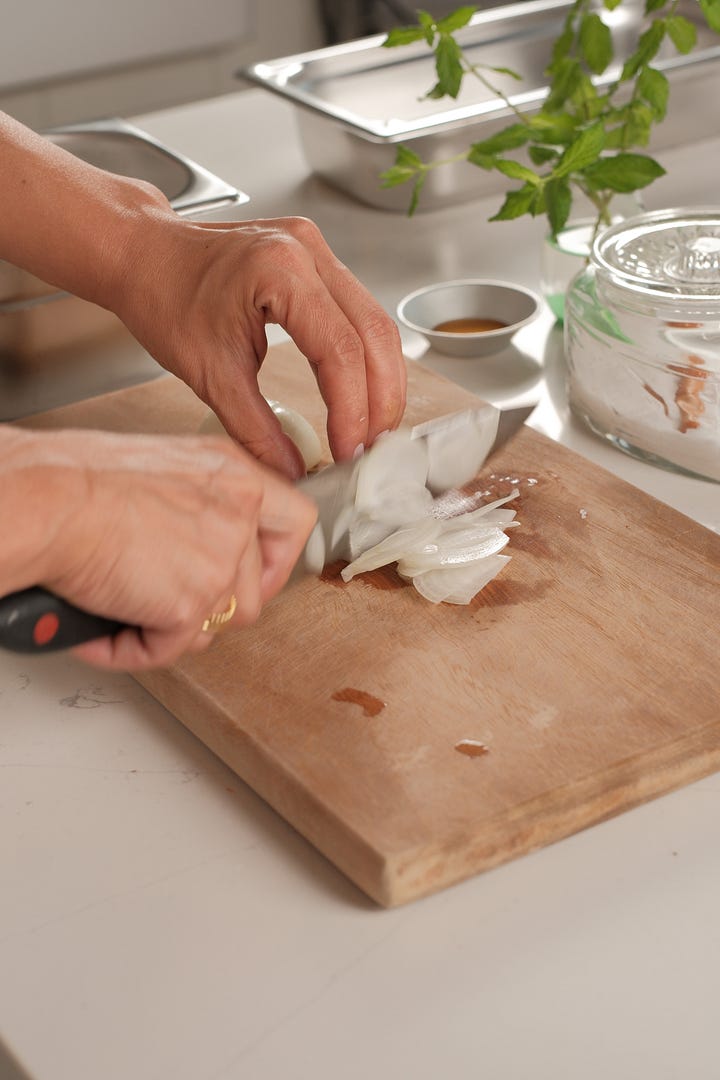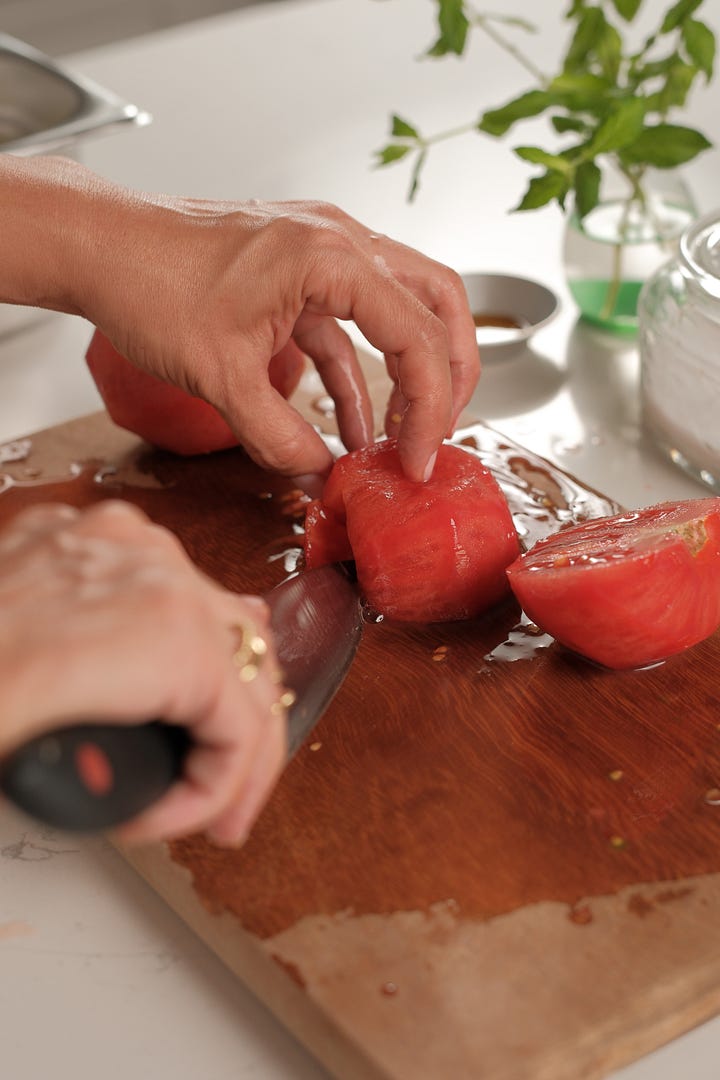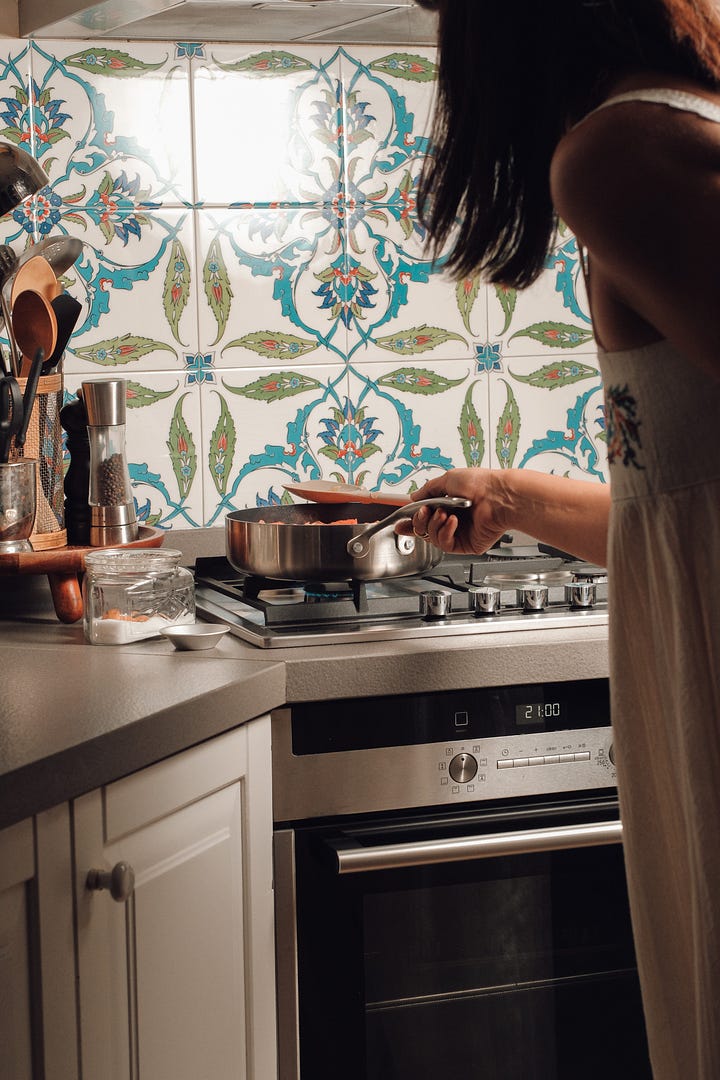Domates Pilaki
A summer zeytinyağlı best left overnight to find its depth.
Imagine a summer table in Istanbul: plates glistening with olive oil, vegetables or fish sweetened by garlic. Among the meze, pilaki sits quietly, but it carries centuries. Introduced through Aegean kitchens and embraced in Ottoman Istanbul, pilaki became the essence of the zeytinyağlı tradition: vegetables cooked gently in olive oil, served cool, and made for sharing.
Tomatoes were not part of the first pilaki. Those early versions relied on olive oil, onions, garlic, and spices. The tomato version only appeared once the fruit became common in the 19th century. This is domates pilaki, where the tomato takes center stage. Some cooks use green tomatoes or add rice to bind the sauce.
Ours is the stripped-back, simple one: ripe summer tomatoes, slow cooking, nothing extra. Just peeled tomatoes, onions, and garlic simmered until soft and sweet. The key is patience: low heat, so the tomatoes soften but don’t collapse.
A standout pilaki leaves the taste of olive oil on the palate without greasiness. The sauce must rest overnight if possible to deepen and thicken, the oil glinting like amber on the surface.
For us, pilaki is more than summer cooking. It’s a dish that returns each year, always plated on my mother’s tulip-patterned porcelain.
An heirloom once carried across continents, now set quietly on our table. Both the plates and the pilaki remind us how food holds memory.




Domates Pilaki
Serves 6
INGREDIENTS
6 ripe tomatoes (about 800 g), peeled and sliced into crescents
2 medium onions (200 g), halved and thinly sliced
4 garlic cloves, thinly sliced
1–2 tsp date syrup, to taste
Juice of half a lemon
80 ml good-quality olive oil
Salt and freshly ground black pepper
A small handful of fresh mint, finely sliced
20 ml extra virgin olive oil, to finish
METHOD
Warm 80 ml olive oil in a wide Dutch oven or sauté pan over low heat. Add the onions and garlic with a pinch of salt. Cook slowly, stirring now and then, until completely soft and translucent, about 15–20 minutes. They should collapse without taking on color.
Add the peeled, sliced tomatoes — cut just thick enough so they soften without falling apart. Keep the heat at a gentle simmer, uncovered, for 40–45 minutes. Stir occasionally, until the sauce thickens and the oil begins to rise to the surface.
Remove from the heat. Stir in the date syrup, then the lemon juice. Adjust seasoning with salt, pepper, and a touch more lemon if needed. Fold in the remaining olive oil. Cool to room temperature in the pot, then refrigerate several hours or overnight.
Let the dish cool to room temperature in the pot. Refrigerate for several hours, preferably overnight.
Serve cold or at cool room temperature. Garnish with fresh mint just before serving.
Kitchen Notes
When done properly, the tomatoes soften into a silky texture, their color turning sunset red, with the oil separating slightly on top.
Pilaki tastes best after resting overnight, when the flavors deepen and the olive oil thickens slightly.
How to peel tomatoes (by blanching):
Bring a pot of water to a boil. Score a small “X” on the bottom of each tomato with a sharp knife. Drop the tomatoes into the boiling water for about 30 seconds, just until the skins start to loosen. Transfer them immediately to a bowl of ice water to stop the cooking. Once cooled, the skins will slip off easily.
MENU
Chilled Carrot and Yogurt Meze (Havuç Tarator)
Mercimek Köftesi (Turkish Red Lentil Balls)
Served with a lemony herb yogurt dipping sauce
Domates Pilaki
Paired with charred asparagus and dukkah.
Aegean Fish Cakes (Balık Köftesi)
Served with watercress, sorrel, rocket salad & pickled red onion.
Mastic Muhallebi




🫠🫠🫠